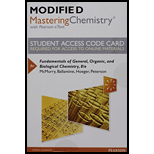
Concept explainers
(a)
Interpretation:
The amino sugar rings in the given structure has to be identified.
Concept introduction:
Carbohydrates (sugars) are naturally-occurring polyhydroxy
Monosaccharides are the simplest carbohydrates, having a hydrocarbon chain that carries alcohol functional groups on all but one carbon. The remaining carbon may carry an aldehyde group (in the case of an aldose) or a ketone group (in the case of ketoses).
Amino sugars are carbohydrate derivatives in which an
(b)
Interpretation:
The unmodified sugar ring in the given structure has to be identified.
Concept introduction:
Carbohydrates (sugars) are naturally-occurring polyhydroxy aldehydes and ketones.
Monosaccharides are the simplest carbohydrates, having a hydrocarbon chain that carries alcohol functional groups on all but one carbon. The remaining carbon may carry an aldehyde group (in the case of an aldose) or a ketone group (in the case of ketoses).
Amino sugars are carbohydrate derivatives in which an
(c)
Interpretation:
The non-sugar ring in the given structure has to be identified.
Concept introduction:
Carbohydrates (sugars) are naturally-occurring polyhydroxy aldehydes and ketones.
Monosaccharides are the simplest carbohydrates, having a hydrocarbon chain that carries alcohol functional groups on all but one carbon. The remaining carbon may carry an aldehyde group (in the case of an aldose) or a ketone group (in the case of ketoses).
Amino sugars are carbohydrate derivatives in which an
Want to see the full answer?
Check out a sample textbook solution
Chapter 20 Solutions
Modified Mastering Chemistry With Pearson Etext -- Standalone Access Card -- For Fundamentals Of General, Organic, And Biological Chemistry (8th Edition)
- What shape do carbohydrate chain linked with alfa (1,4) glycosidic bonds generally have ?arrow_forwardWhich bond(s) in α-D-glucose must be broken tochange its configuration to β-D-glucose? Which bond(s) to convert D-glucose to Dmannose? Which bond(s) to convert one “chair” form of D-glucose to the other?arrow_forwardThe common naturally occurring form of cysteine has a chirality center that is named (R), however; (a) What is the relationship between (R)-cysteine and (S)-alanine? (b) Do they have the opposite three-dimensional configuration (as the names might suggest) or the same configuration? (c) Is (R)-cysteine a D-amino acid or an L-amino acid?arrow_forward
- Match the following structural composition with the corresponding polysaccharide Linear homoglycan of glucose connected by α1-4 linkages Branched glycan formed by alternating units of D-galactose and L-galactose Linear sulfated chains of alternating β-D-galactopyranose and 3,6-anhydro- α-galactopyranosyl units Poly-β-Dmannopyranosyluronic acid and/or Poly-α-L-gulopyranosyluronic acid Repeating Poly-D-galacturonic acid residues…arrow_forwardWhich is the stable conformation of ribose sugar, Fischer or furanose ring? Why?arrow_forwardDescribe in detail the composition and structure of peptidoglycan. Why does peptidoglycan contain the unusual d-isomers of alanine and glutamic acid rather than the l-isomers observed in proteins?arrow_forward
- What are/Give the 4 structures of L-Cysteine from highly protonated to deprotonated form? What are the charges?arrow_forwardImagine a trisaccharide that has D-Altrose, D-Gulose, and D-Ribose. D-Altrose is bonded to D-Gulose in an α(1→4) glycosidic bond and D-Ribose is bonded to D-Altrose in an α(1→6) glycosidic bond. Draw the imaginary trisaccharide using Haworth projection with the appropriate representation of each monosaccharide.arrow_forwardPenicillin G is a natural antibiotic that is useful for treating infections caused by Gram positive bacteria. What is the functional benefit of the semi-synthetic antimicrobials carbenicillin and ampicillin, generated by chemical modification of the R group so their R groups each are a bit different than the R group seen with penicillin G?arrow_forward
- What structural relationship is indicated by term D-sugar? Why are +glucose and -fructose classified as D-sugarsarrow_forwardDraw the two possible Haworth structures (both alpha and beta anomers) for the following monosaccharides and give their corresponding systematic names. [Show the stepwise process] D-Ribose D-Galactose D- Fructosearrow_forwardWhat structural relationship is indicated by term D-Sugar ? Why are glucose and frutose both characterizes as sugars ? Write the principal functional role of D-Glucose , D- Fructose, and D- Galactose ?arrow_forward
 BiochemistryBiochemistryISBN:9781319114671Author:Lubert Stryer, Jeremy M. Berg, John L. Tymoczko, Gregory J. Gatto Jr.Publisher:W. H. Freeman
BiochemistryBiochemistryISBN:9781319114671Author:Lubert Stryer, Jeremy M. Berg, John L. Tymoczko, Gregory J. Gatto Jr.Publisher:W. H. Freeman Lehninger Principles of BiochemistryBiochemistryISBN:9781464126116Author:David L. Nelson, Michael M. CoxPublisher:W. H. Freeman
Lehninger Principles of BiochemistryBiochemistryISBN:9781464126116Author:David L. Nelson, Michael M. CoxPublisher:W. H. Freeman Fundamentals of Biochemistry: Life at the Molecul...BiochemistryISBN:9781118918401Author:Donald Voet, Judith G. Voet, Charlotte W. PrattPublisher:WILEY
Fundamentals of Biochemistry: Life at the Molecul...BiochemistryISBN:9781118918401Author:Donald Voet, Judith G. Voet, Charlotte W. PrattPublisher:WILEY BiochemistryBiochemistryISBN:9781305961135Author:Mary K. Campbell, Shawn O. Farrell, Owen M. McDougalPublisher:Cengage Learning
BiochemistryBiochemistryISBN:9781305961135Author:Mary K. Campbell, Shawn O. Farrell, Owen M. McDougalPublisher:Cengage Learning BiochemistryBiochemistryISBN:9781305577206Author:Reginald H. Garrett, Charles M. GrishamPublisher:Cengage Learning
BiochemistryBiochemistryISBN:9781305577206Author:Reginald H. Garrett, Charles M. GrishamPublisher:Cengage Learning Fundamentals of General, Organic, and Biological ...BiochemistryISBN:9780134015187Author:John E. McMurry, David S. Ballantine, Carl A. Hoeger, Virginia E. PetersonPublisher:PEARSON
Fundamentals of General, Organic, and Biological ...BiochemistryISBN:9780134015187Author:John E. McMurry, David S. Ballantine, Carl A. Hoeger, Virginia E. PetersonPublisher:PEARSON





